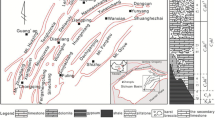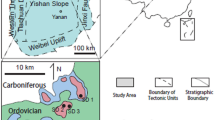Abstract
This study deals with superb fault-controlled, bedding-parallel dolomite in the shallow marine platform carbonates of the Samana Suk Formation (middle Jurassic), southern Hazara basin, NW Pakistan. Field observations, petrographic studies, mineralogical and isotopic analyses, and porosity-permeability analyses allow to unravel the diagenetic evolution of documented diagenetic phases and their impact on the reservoir behavior. Various diagenetic phases are recognized, which include (i) two episodes of replacive dolomites (Dol. I and Dol. II), (ii) initial phase of white calcite cement (WC-I), (iii) saddle dolomite (SD), (iv) late phase of white calcite cement (WC-II), and (v) transparent calcite cement (TC). In addition, other diagenetic features are bedding-parallel stylolites (PBSs), cataclastic deformation, and dissolution. Stable C- and O-isotope signatures confirmt that elevated temperature fluids resulted in the formation of the various dolomite and calcite phases. Porosity-permeability studies revealed enhanced porosity in the replacive dolomite (i.e., Dol. I and Dol. II), but late stage cementation in relation to calcite and dolomite cementation showed adverse effect on the reservoir quality. Furthermore, diagenetic alterations (i.e., brecciation and dissolution) along faults contributed in the enhancement of reservoir properties.
In conclusion, dolomitization occurred due to the percolation of Mg-rich fluids along the Haro Fault and its splays. Dewatering of basinal fluids from the underlying siliciclastic rocks or deep and hot hydrothermal fluids may be the possible source of dolomitization.











Similar content being viewed by others
References
Ahsan N, Chaudhry MN (2008) Geology of Hettangian to middle Eocene rocks of Hazara and Kashmir Basins, Northwest Lesser Himalayas. Pakistan Geol Bull Punjab Univ 43:131–152
Ali JR and Aitchison J (2008) Gondwana to Asia: plate tectonics, paleogeography and the biological connectivity of the Indian sub-continent from the Middle Jurassic through latest Eocene (166–35 Ma). 88(3–4), 145–166
Angiolini L, Balini M, Garzanti E, Nicora A, Tintori A (2003) Gondwana deglaciation and opening of neotethys: the Al Khlata and Saiwan Formations of interior Oman. Palaeogeogr Palaeoclimatol Palaeoecol 19:699–123
Bullen SB, Sibley DF (1984) Dolomite selectivity and mimic replacement. Geology 12:655–658
Burg JP (2011) The Asia-Kohistan-India collision: review and discussion. In: Brown D, Ryan PD (eds) Arc-Continent Collision, Frontiers in Earth Sciences. Springer-Verlag, Berlin, pp. 279–309
Calkins JA, Offield T W and Abdullah SKM (1975) Geology of the Southern Himalayas in Hazara, Pakistan and adjacent areas. Geological Investigation in Pakistan. p.124
Chatterjee S, Scotese CR (2010) The wandering Indian plate and its changing biogeography during the late Cretaceous-early Tertiary period. Ed. New Aspects of Mesozoic Biodiversity. Lect Notes Earth Sci 132:105–126
Chatterjee S, Goswami A, Scotese CR (2013) The longest voyage: tectonic, magmatic, and paleoclimatic evolution of the Indian plate during its northward flight from Gondwana to Asia. Gondwana Res 23:238–267
Chaudhry MN, Ahsan N, and Ghazanfar M (1998) A preliminary account of sedimentology of Hazara Basin from Jurassic to Eocene: Abstract volume 13th Himalaya-Karakoram-Tibet Workshop, Peshawar, pp. 41–43
Choquette PW, James NP (1988) Introduction. In: James NP, Choquette PW (eds) Paleokarst. Springer-verlag, New York, pp. 1–21
Coward MP, Butler RWH, Chambers AF, Graham RH, Izatt CN, Khan MA, Knipe RJ, Prior DJ, Treloar PJ, Williams MP (1988) Folding and imbrications of the Indian crust during the Himalayan collision. Philos Trans R Soc Lond A326:89–116
Davies GR, and Smith LB Jr (2006) Structurally controlled hydrothermal dolomite reservoir facies: An overview. AAPG Bulletin, 90(11):1641–1690
Dewit J, Huysmans M, Muchez P, Hunt DW, Thurmond JB, Verges J, Saura E, Fernandez N, Romaire I, Esestime P, Swennen R (2012) Reservoir characteristics of fault controlled hydrothermal dolomite bodies: Ramales Platform case study. In: Garland J, Neilson JE, Laubach SE, Whidden KJ (eds) Advances in Carbonate Exploration and Reservoir Analysis, Geological Society of London. Special Publications 370, London, pp. 83–109
Dickson JAD (1966) Carbonate identification and genesis as revealed by staining. J Sediment Petrol 36:491–505
Ferrill DA, Morris P, Evans MA, Burkhard M, Groshong RH, Onasch CM (2004) Calcite twin morphology: a low-temperature deformation geothermometer. J Struct Geol 26(8):1521–1529
Fursich FT, Callomon JH, Pandey DK, Jaitly AK (2004) Environments and faunal pattern in the Kachh Rift Basin, western India, during Jurassic. Riv Ital Paleontol Stratigr 110:181–190
Garzanti E (1993) Sedimentary evolution and drowning of a passive margin shelf Giumal Group; Zanskar Tethys Himalaya, India: palaeoenvironmental changes during final break-up of Gondwanaland, in P.J. Treloar and M.P. Searle, eds. Himalayan Tectonics. Geol Soc Spec Pub 74:277–298
Gomez-Rivas E, Corbella M, Martín-Martín JD, Stafford SL, Teixell A, Bons PD, Cardellach E (2014) Reactivity of dolomitizing fluids and Mg source evaluation of fault-controlled dolomitization at the Benicassim outcrop analogue (Maestrat Basin, E Spain). Mar Pet Geol 55:26–42
Gonzales-Casado JM, Garcia-Cuevas C (1999) Calcite twins from microveins as indicators of deformation history. J Struct Geol 21:875–889
Hendry JP, Gregg JM, Shelton KL, Somerville ID, Crowley SF (2015) Origin, characteristics and distribution of fault-related and fracture-related dolomitization: insights from Mississippian carbonates. Isle Of Man, Sedimentology 62:717–752
Kazmi, AH and Jan MQ (1997) Geology and tectonics of Pakistan. Graphic Publishers Pakistan, 554
Khan SD, Walker DJ, Hall SA, Burke KC, Shah MT, Stockli L (2009) Did Kohistan-Ladakh island arc collide first with India? Geol Soc Am Bull 121:366–384
Lacombe O (2010) Calcite twins, a tool for tectonic studies in thrust belts and stable orogenic forelands. Oil & Gas Science and Technology–rev. IFP Energies Nouvelles 65(6):809–838
Lacombe O, Amrouch K, Mouthereau F, Dissez L (2007) Calcite twinning constraints on late Neogene stress patterns and deformation mechanisms in the active Zagros collision belt. Geology 35(3):263–266
Lee T, Lawver LA (1995) Cenozoic plate reconstruction of Southeast Asia. Tectonophysics 251(1–4):85–138
Lopez-Horgue MA, Iriarte E, Schroder S, Fernandez-Mediola PA, Caline B, Corneyllie H, Fremont J, Sudrie M, Zerti S (2010) Structurally controlled hydrothermal dolomites in Albian carbonates of the Ason Valley, Basque Cantabrian Basin. Northern Spain Mar Pet Geol 27(5):1069–1092
Lucia, F. J. and Major, R. P. (1994). Porosity evolution through hypersaline reflux dolomitization. In: Purser, B. H., Tucker, M. E and Zenger, D. H. Eds, Dolomites, a volume in honor of Dolomieu. Int. Assoc. Sedimentology. Spec. Publ. 21, 325–341.
Lumsden DN (1979) Discrepancy between thin section and X-ray estimates of dolomite in limestone. J Sediment Petrol 49:429–436
Martín-Martín JDA, Trave A, Gomez-Rivas E, Salas R, Sizun JP, Verges J, Corbella M, Stafford SL, Alfonso P (2015) Fault-controlled and stratabound dolostones in the Late Aptian-earliest Albian Benassal Formation (Maestrat Basin, E Spain): petrology and geochemistry constrains. Mar Pet Geol 65:83–102
McKenzie D, Sclater JG (1971) The evolution of the Indian Ocean since the Late Cretaceous. Geophys J Int 24(5):437–528
Meyers WJ (1991) Calcite cement stratigraphy. In: C.E. Baker and O.C. Kopp (eds), luminescence microscopy and spectroscopy: qualitative and quantitative aspects. SEPM Short Course 25:133–148
Murray RC, Lucia FJ (1967) Cause and control of dolomite distribution by rock selectivity. Geol Soc Am Bull 78:21–35
Nader FH, Dumont C, Shah MM, Garcia D, Swennen R, Daniel J-M, Lerat O, and Doligez B (2009) From field study to numerical modelling of hydrothermal dolomitization in Early Cretaceous platform carbonates (Cantabrian mountains, northern Spain). J Geochem Explor, 101, pp. 73
Nielsen P, Swennen R, Keppens E (1994) Multiple-step recrystallization within massive ancient dolomite units: an example from the Dinantian of Belgium. Sedimentology 41:567–584
Niemann JC, Read JF (1988) Regional cementation from unconformity-recharge aquifer and burial fluids. Mississipian Newman Limestone, Kentucky. J Sed Petrol 58:688–705
Patriat P, Achache J (1984) India-Eurasia collision chronology and its implications for crustal shortening and driving mechanisms of plates. Nature 311:615–621
Radke BM, Mathis RL (1980) On the formation and occurrence of saddle dolomite. J Sediment Res 50(4):1149–1168
Reeder RJ (1991) An over-view of zoning in carbonate minerals. In: C.E. Baker and O.C. Kopp (Eds), luminescence microscopy and spectroscopy: Qualitative and quantitative aspects. SEPM short course 25, pp. 77–82
Reuber I (1986) Geometry of accretion and oceanic thrusting of the Spongtang ophiolite, Ladakh-Himalaya. Nature 321:592–596
Rosenbaum J, Sheppard SM (1986) An isotopic study of siderites, dolomites and ankerites at high temperatures. Geochim Cosmochim Acta 50:1147–1150
Rowley DB (1996) Age of initiation of collision between India and Asia: a review of stratigraphic data. Earth Planetary Lett 145:1–13
Searl A (1989) Saddle dolomite: a new view of its nature and origin. Mineral Mag 53(5):547–555
Sengor, A. M. C., Altiner, D., Cin, A., Ustaomer, T. and Hsu, K.J. (1988). Origin and assembly of the Tethyside orogenic collage at the expense of Gondwanaland. In: Audley-Charles, M.G. & Hallam, A. Eds. Gondwana and Tethys. Geol. Soc. Lond., Spec Publ 37: 81–119.
Shah SMI (1977) Stratigraphy of Pakistan. Geol Surv Pakistan, Quetta, Mem Geol Surv 12:138
Sharp I, Gillespie P, Morsalnezhad D, Taberner C, Karpuz R, Verges J, Horbury A, Pickard N, Garland J, Hunt D (2010) Stratigraphic architecture and fracture-controlled dolomitization of the Cretaceous Khami and Bangestan groups: an outcrop case study, Zagros Mountains, Iran. In: van Buchem FSP, Gerdes KD, Esteban M (eds) Mesozoic and Cenozoic Carbonate Systems of the Mediterranean and the Middle East: Stratigraphic and Diagenetic Reference Models. Geol. Soc, Lond. Sp. Publ. 329, London, pp. 343–396
Sibley DF, Gregg JM (1987) Classification of dolomite rock textures. J Sediment Petrol 57:967–975
Van der Voo R, Spakman W, Bijwaard H (1999) Tethyan subducted slabs under India. Earth Planet Sci Lett 171:7–20
Vandeginste V, John CM, Cosgrove JW, Manning C (2014) Dimensions, texture distribution, and geochemical heterogeneities of fracture-related dolomite geobodies hosted in Ediacaran Limestones, Northern Oman. AAPG Bull 98(9):1789–1809
Wachter E and Hayes JM (1985) Exchange of oxygen isotopes in carbon-dioxidephosphoric acid systems. Chem Geol, 52, 365–374
Yeats RS, Hussain A (1987) Timing of structural events in the Himalayan foothills of northern Pakistan. J Geol Soc London 153:677–680
Author information
Authors and Affiliations
Corresponding author
Additional information
This article is a part of Topical Collection on Arabian Plate: Lithosphere Dynamics, Sedimentary Basins &; Geohazards
Rights and permissions
About this article
Cite this article
Shah, M.M., Ahmed, W., Ahsan, N. et al. Fault-controlled, bedding-parallel dolomite in the middle Jurassic Samana Suk Formation in Margalla Hill Ranges, Khanpur area (North Pakistan): petrography, geochemistry, and petrophysical characteristics. Arab J Geosci 9, 405 (2016). https://doi.org/10.1007/s12517-016-2413-y
Received:
Accepted:
Published:
DOI: https://doi.org/10.1007/s12517-016-2413-y




